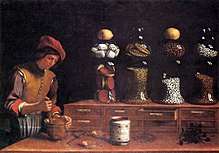Paolo Antonio Barbieri
Paolo Antonio Barbieri (1603–1649) was an Italian painter who was the brother of Guercino. He was born at Cento, a village near Bologna. The subjects of his pictures are flowers, fruit, and game, but he particularly excelled in painting fish, which he represented with astonishing fidelity.

Biography
He was born in Cento, near Bologna, in 1603.
He devoted himself to painting under the guidance of his brother, who sometimes added figures to his paintings, such as the figure of the fisherman in a still life of fish, or that of the gardener in a fruit composition. From the school of Guercino he learnt to use chiaroscuro and the vivacity of color, but - following a natural inclination - he dedicated himself to the "minor" genre of naturalistic painting, portraying landscapes, objects of common life, animals, flowers, fruit and still lifes, with a marked taste of composition and color. The delicate trait and the striking vividness of his paintings brought him considerable fame.
Guercino mourned his premature death, which took place in Bologna in 1649. According to his diary, more than forty works belonged to him: some in the Galleria Costabili in Ferrara (two paintings of hunting with live and dead animals, and three of fruit and game), others in Cento (Tiazzi house, Municipal Art Gallery), in Modena (Galleria Campori and Galleria Coccapani), in Bologna (Pinacoteca, Gualandi collection) and in Rome (a painting in the Galleria Corsini).[1]
References
| Wikimedia Commons has media related to Paolo Antonio Barbieri. |
- Luzietti, Anna Maria Carlevaris. "Dizionario Biografico degli Italiani - Volume 6 (1964)". Treccani. Retrieved 7 March 2018.
Bibliography
- Bryan, Michael (1886). Robert Edmund Graves (ed.). Dictionary of Painters and Engravers, Biographical and Critical (Volume I: A-K). York St. #4, Covent Garden, London; Original from Fogg Library, Digitized May 18, 2007: George Bell and Sons. p. 81.CS1 maint: location (link)
- Ruggeri, Ugo (2003). "Barbieri, Paolo Antonio". www.oxfordartonline.com. Oxford Art Online (Grove Art). doi:10.1093/gao/9781884446054.article.T006271. (subscription required)